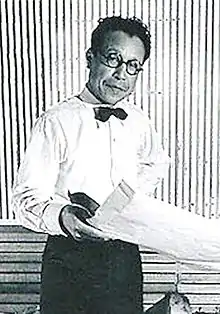
Isoya Yoshida
Isoya Yoshida (吉田 五十八, Yoshida Isoya, December 19, 1894, - March 24, 1974) was a Japanese architect. He graduated from Tokyo Art School (now Tokyo National University of Fine Arts and Music) in 1923. His style, known as sukiya, combines elements of traditional Japanese architecture and modernist architecture. Among his notable projects was the fourth iteration of the Kabuki-za,[1] which was torn down in 2010 and replaced in 2013 by a new structure designed by Kengo Kuma. Yoshida was born and died in Tokyo.
References
- ↑ "The Curtain Rises on an All-New Kabukiza". nippon.com. 16 May 2013. Retrieved 14 December 2021.
Completed in 1951, this incarnation was built to the design of Yoshida Isoya (1894‒1974), a well-known proponent of the sukiya-zukuri architectural style that borrowed liberally from traditional tea-house aesthetics and made heavy use of natural materials.
- J. P. Noffsinger (1980). Isoya Yoshida: Modern/Traditional Architect of Japan. Monticello, IL.
This article is issued from Wikipedia. The text is licensed under Creative Commons - Attribution - Sharealike. Additional terms may apply for the media files.